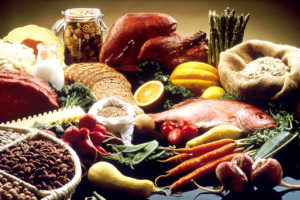When is the last time you had a nice plate of liver for dinner, or drank a cup of bone broth? How about eating bone-in and fattier cuts of meat? If you’re like the average person, the answer is probably not very recently, if ever at all. Some of you may have never even heard of bone broth, or the idea of actually eating organ meats.
Instead, most people today, when it comes to meat consumption, rely on boneless, skinless chicken breasts, ground beef, boneless pork chops, and other boneless, and usually lean types of meat. Now, these foods are all healthy, and they do provide nice amounts of nutrients. However, by relying exclusively on these foods, you are missing out on valuable nutrients that are found in the fattier cuts of meat, as well as the organs and bones. Essentially, if you want to be nutritionally balanced, you need to start consuming these odds and ends, in addition to the typical meat consumed; and this is done by eating “nose-to-tail”.
Nose-To-Tail Eating
Nose-to-tail eating doesn’t happen that much anymore, but this was the norm for many earlier cultures. You’ve probably heard of the Native Americans utilizing all parts of the animal, and this was definitely the case. Some cultures today still make the odds and ends a significant part of their diets, including many cultures in Central America and South America, the Philippines and various Pacific islanders, as well as various modern-day hunter-gatherer tribes in certain African regions.
Now, when it comes to nutrition, it turns out these earlier cultures knew just exactly what they were doing. Not only were they acting more ethically and responsibly by using all parts of the animal, they were also getting loads of nutrients by consuming all of the different parts. As you will see, there are many different benefits to eating all different parts of the animal, many of which the vast majority of people in modern society could benefit from.
Organ Meats
Arguably the most important parts of the animal to consume in order to eat nose-to-tail are the organ meats. Organ meats are loaded with nutrition, and these meats were often the first choice for Native Americans and other earlier cultures, since they knew they were highly nutrient-dense. They provide much more vitamins and minerals compared to the muscle meat counterparts to the respective animals they come from. For example, organ meats typically have high levels of vitamin A, vitamin B12, vitamin B6, most of the other B-complex vitamins, as well as solid amounts of zinc and iron (1). In turn, you’ll experience many aspects of improved health, since these vitamins and minerals are important for energy, brain function, immune health, and much more (2) (3). It is primarily for these reasons why I list organ meats as nutritional powerhouses within an optimal diet.
Now, within this, liver appears to be the most nutrient-dense organ meat out there. It provides levels of vitamin A and B12 that are way higher than muscle meat, upwards of 100 times higher! And it also has a lot of omega-3 fatty acids in each serving. Heart, kidney, tripe, and other organs are also dense in these nutrients, just not as much compared to liver; however, they are still valuable as well.
Organ meats are a very easy way to get nutrients that you otherwise wouldn’t be consuming, at least not as much. In turn, you will be much more balanced because you are receiving more nutrients that your body needs. You’ll likely have more energy, and your overall health will improve.
Even further, organ meats provide crucial nutrients that most people are deficient in, and ones that have devastating consequences when under consumed. For example, deficiencies in vitamin A and the B-complex vitamins (especially B12) are relatively common, in which a deficiency in B-complex vitamins greatly increases the risk for many neurological disorders, including Alzheimer’s, Parkinson’s, as well as general mood disturbances and cognitive impairments (4). Furthermore, vitamin A deficiency is related with vision problems, decreased immune health, and anemia (5). Thus, organ meats are a great way to provide critical nutrients that are sometimes missing from one’s diet, and will help to give you vital nutrients you might be deficient or low in.
More Benefits of Organ Meats
Furthermore, organ meats likely are more easily digestible compared to muscle meat (6), of course, as long as you can get past their initial taste. So, if someone has digestive issues with muscle meats, they very well may be able to tolerate organ meats from the respective animal. If this is the case for you, try out a small amount of organ meat and see if are able to tolerate it.
As hinted at, obviously a con with organ meats is their taste. However, you don’t have to consume straight organ meats to get the benefit. Mix it with muscle meat if you need to. For example, fry up some ground beef with a little bit of beef liver mixed in. On the other hand, if you like organ meats by themselves, then by all means go for it! Aim to consume around four ounces of organ meats per week but be careful not to overdo it (probably not more than a pound per week).
Last but not least, organ meats are cheap! Despite having more nutrition than muscle meats, organ meats are almost always cheaper than muscle meats, which makes this a no-brainer purchase if you’re conscious about your health.
Bones
Bones are another great part of the animal to consume. They contain many valuable nutrients, including magnesium, calcium, glycine, and collagen, among others (7). Furthermore, bone marrow contains healthy fats, as well as many different vitamins and minerals (8).
And most people in society could afford to get more of these key nutrients, especially magnesium, glycine, and collagen. Glycine is important for cardiovascular, metabolic, immune, and neurological health, and plays a role in sleep (9). Magnesium is important for hundreds of bodily reactions, the most relevant in today’s society include stress reduction, sleep, and relaxation, and hormonal health (10). Also, collagen is vital for bone, skin, and joint health (11) (12), and calcium is important for a healthy heart, strong bones, and for an efficient nervous system, among other things (13).
With further regard to glycine, many people consume too much methionine, which is found in muscle meat, but not enough glycine, so consuming bone-based products helps to balance this ratio and promote optimal health (14). Without a balanced meat to bone consumption (i.e methionine:glycine ratio), you are at an increased risk for various diseases.
How to Eat Bones
Overall, you can see why eating bones is important. Of course, you’re not going to take a bone out of a pork chop or something and start chomping on it (unless it’s the soft end with the marrow). No, instead there are easier ways to get the benefits. The first is by making bone broth, and this is simply done by simmering bones in water, a splash of vinegar, and various vegetables, for the majority of the day, and then straining the solution. Doing this will extract the key nutrients from the bones, leading to a very nutrient-dense solution (15) (16).
Another way is to consume the edible soft bones of animals, such as the marrow on cooked chicken drumstick bones, or the edible bones of fish, such as sardines. In whatever way you do it, consuming various bone products are another way to provide you with valuable nutrients, most of which most people aren’t getting enough of.
Fatty Cuts of Meat
The last item to complete your nose-to-tail eating quest is fatty meat, which includes pork ribs, chicken thighs, turkey legs, and obviously many more items. Fatty cuts of meat have received a bad rap, although this is turning around a little bit with the Paleo trends and keto trends. Now, I don’t particularly like any trend because I’ve always believed that true health comes from moderation and balance, whereas trends will come and go. However, in terms of the fattier meat revolution that has come along with this, this does have merit.
Indeed, the fattier cuts of meat oftentimes provide high levels of healthy fatty acids (e.g. omega-3 fatty acids), as well as other important nutrients, including vitamin A (17). These meats are also carriers of fat-soluble vitamins A, D, E, and K, which are vital for many aspects of overall health, such as growth, reproduction, hormonal health, and immune health (18).
Further Roles of Fatty Meats
Furthermore, consuming fattier meats leads to greater satisfaction, whereas eating exclusively lean meats will most likely lead to increased hunger. It’s similar to why eating low-fat or no-fat dairy is not the best option, and why full-fat dairy reigns supreme. It is interesting to see that the people who are overweight are usually the ones eating the low-fat varieties of yogurt, yet high-fat dairy consumption is associated with lower obesity (19). And, similarly, as society has gone away from eating fattier meats, obesity levels have increased. Sure, there are other obvious factors, but perhaps eating meals that provide satisfaction (along with being healthy, of course) can go a long way in helping one to stave off hunger and to lose weight.
I’m not suggesting or encouraging you to eat fatty meats for all of your meals, but rather that you eat them occasionally along with all other kinds of meat and animal products. If you’re worried about cholesterol or saturated fat, you can always consult with your doctor, but recent research is starting to show that cholesterol and saturated fat aren’t as evil as initially thought, and they are actually necessary for and beneficial to many aspects of health and wellness. Of course, you still need to consume these in moderation; anything in excess will obviously harm your health.
Nose-to-Tail Eating for Health
Overall, if you want to be getting the most “bang for your buck” when it comes to animal products consumption, you need to be eating nose-to-tail. Yes, be sure to include the typical lean muscle meats and such that you’re most likely already eating, but also balance this with all of the other parts of the animal, including organ meats, bones, and fattier cuts of meat. If you do, you’ll be consuming a boatload of nutrients, which will help you on your quest to become a healthier individual, physically and mentally.
References
1. Williams, P. (2007). Nutritional composition of red meat. Nutrition & Dietetics, 64, S113-S119.
2. Kennedy D. O. (2016). B Vitamins and the Brain: Mechanisms, Dose and Efficacy–A Review. Nutrients, 8(2), 68. https://doi.org/10.3390/nu8020068
3. Walker, C. F., Kordas, K., Stoltzfus, R. J., & Black, R. E. (2005). Interactive effects of iron and zinc on biochemical and functional outcomes in supplementation trials–. The American journal of clinical nutrition, 82(1), 5-12. https://doi.org/10.1093/ajcn/82.1.5
https://doi.org/10.1111/j.1747-0080.2007.00197.x
4. Sechi, G., Sechi, E., Fois, C., & Kumar, N. (2016). Advances in clinical determinants and neurological manifestations of B vitamin deficiency in adults. Nutrition Reviews, 74(5), 281-300. https://doi.org/10.1093/nutrit/nuv107
5. Wiseman, E. M., Bar-El Dadon, S., & Reifen, R. (2017). The vicious cycle of vitamin A deficiency: A review. Critical reviews in food science and nutrition, 57(17), 3703-3714. https://doi.org/10.1080/10408398.2016.1160362
6. Wu, G., Hicks, T. M., Frost, D., Staincliffe, M., & Farouk, M. M. ORGAN-MEAT FUNCTIONALITY AND DIGESTIBILITY. http://icomst-proceedings.helsinki.fi/papers/2018_06_57.pdf
7. Kakimov, A., Yessimbekov, Z., Suychinov, A., Japanov, T., & Zolotov, A. (2017). Mineral and amino acid composition of meat-bone paste. In International Scientific and Practical Conference World science (Vol. 4, No. 5, pp. 5-7). ROST.
8. Tjota, H., Owen, A., Defiana, S. K., & Handoko, V. Exploration of Kaledo as Typical Food in Central Sulawesi, Indonesia. www.questjournals.org
9. Razak, M. A., Begum, P. S., Viswanath, B., & Rajagopal, S. (2017). Multifarious beneficial effect of nonessential amino acid, glycine: a review. Oxidative medicine and cellular longevity, 2017. https://doi.org/10.1155/2017/1716701
10. De Baaij, J. H., Hoenderop, J. G., & Bindels, R. J. (2015). Magnesium in man: implications for health and disease. Physiological reviews. Doi: 10.1152/physrev.00012.2014
11. Bolke, L., Schlippe, G., Gerß, J., & Voss, W. (2019). A collagen supplement improves skin hydration, elasticity, roughness, and density: Results of a randomized, placebo-controlled, blind study. Nutrients, 11(10), 2494. doi: 10.3390/nu11102494
12. Clark, K. L., Sebastianelli, W., Flechsenhar, K. R., Aukermann, D. F., Meza, F., Millard, R. L., … & Albert, A. (2008). 24-Week study on the use of collagen hydrolysate as a dietary supplement in athletes with activity-related joint pain. Current medical research and opinion, 24(5), 1485-1496. doi: 10.1185/030079908×291967.
13. Pravina, P., Sayaji, D., & Avinash, M. (2013). Calcium and its role in human body. Int. J. Res. Pharm. Biomed. Sci, 4(2), 659-668.
14. Masterjohn, C. (2020). Balancing Methionine and Glycine in Foods: The Database. https://chrismasterjohnphd.com/blog/balancing-methionine-and-glycine-in-foods-the-database
15. Hsu, D. J., Lee, C. W., Tsai, W. C., & Chien, Y. C. (2017). Essential and toxic metals in animal bone broths. Food & nutrition research, 61(1), 1347478. https://doi.org/10.1080/16546628.2017.1347478
16. Shaw, M. H., & Flynn, N. E. (2019). AMINO ACID CONTENT OF BEEF, CHICKEN AND TURKEY BONE BROTH. Journal of Undergraduate Chemistry Research, 18(4), 15. https://www.westmont.edu/sites/default/files/users/user1231/V19No4/Nick%20Flynn_final.pdf
17. Barendse, W. (2014). Should animal fats be back on the table? A critical review of the human health effects of animal fat. Animal Production Science, 54(7), 831-855. doi: 10.1071/AN13536
18. National Research Council (US) Committee on Diet and Health. Diet and Health: Implications for Reducing Chronic Disease Risk. Washington (DC): National Academies Press (US); 1989. 11, Fat-Soluble Vitamins. Available from: https://www.ncbi.nlm.nih.gov/books/NBK218749/
19. Holmberg, S., & Thelin, A. (2013). High dairy fat intake related to less central obesity: a male cohort study with 12 years’ follow-up. Scandinavian journal of primary health care, 31(2), 89–94. https://doi.org/10.3109/02813432.2012.757070




